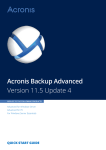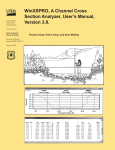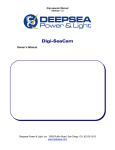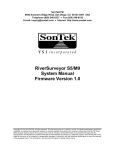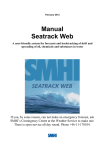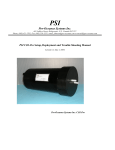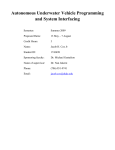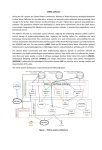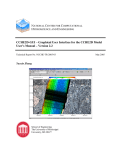Download Quality Assurance Plan for Discharge Measurements Using
Transcript
Quality Assurance Plan for Discharge Measurements Using Broadband Acoustic Doppler Current Profilers U.S. GEOLOGICAL SURVEY OPEN-FILE REPORT 95-701 By Stephen W. Lipscomb CONTENTS Abstract Introduction Training requirements Pre-field office procedures Software and firmware revisions Pre-field inspection Field procedures Vessel installation Instrument check Configuration file setup Discharge measurements Measurement assessment Post-field office procedures Discharge measurement review Documentation and archival of discharge measurements Annual instrument check Periodic review Selected references Abstract The recent introduction of the Acoustic Doppler Current Profiler (ADCP) as an instrument for measuring velocities and discharge in the riverine and estuarine environment promises to revolutionize the way these data are collected by the U.S. Geological Survey. The ADCP and associated software, however, compose a complex system and should be used only by qualified per-sonnel. Standard procedures should be rigorously followed to ensure that the quality of data collected is commensurate with the standards set by the Water Resources Division for all its varied activities in hydrologic investigations. Introduction The Acoustic Doppler Current Profiler (ADCP) is an electronic instrument developed and manufactured by RD Instruments of San Diego, California, that is used to measure water velocities. The instrument transmits acoustic signals into the water column. When the frequency of the transmitted signals is compared with the frequency of backscatter signals reflected off particles in the water, the velocity of the particles and, hence, the water, can be calculated. ADCP's have been widely used by oceanographers to measure currents in the deep-sea environment. More recently, the technology has been adapted to the riverine and estuarine environment and promises to revolutionize the way many streamflow discharge measurements are made by the U.S. Geological Survey (USGS). As ADCP technology has been refined, it has begun to gain acceptance as a viable method for obtaining velocity and discharge data. The primary advantages of making discharge measurements using the ADCP compared with a Price or other point-current meter are that (1) the time required to complete a measurement is reduced; (2) data can be collected throughout the water column and cross section rather than at discrete points; (3) taglines or other stationing devices are unnecessary because the instrument keeps track of distance traveled, provided the bed is stable; and (4) the instrument can be boat-mounted, thus eliminating the installation, maintenance, and liability of costly cableways. The primary disadvantages of using the ADCP compared with a standard Price current meter are its high initial cost; inability to function in shallow water; complexity, requiring an in-depth understanding of the physics, electronics, and software of the system prior to use; and the frequent revisions to hardware, firmware, and software due to the newness of the technology. These revisions generally result in improvements in the accuracy of the data collected; however, they pose problems in dealing with data collected using earlier systems and software. The Office of Surface Water has recognized the utility of the ADCP for many of the tasks performed by various Water Resources Division offices. However, as with any technology or methodology adopted by the Division for the collection and analysis of water resources data, it is critical that strict measures be implemented to ensure the quality and reproducibility of the data throughout our agency. The purpose of this report is to provide a quality assurance plan that, when implemented, will ensure that data collected with ADCP's meet existing accuracy standards and that the procedures used to collect the data are consistent throughout the Division. Specific objectives of the plan are to ensure that: 1. Field and office procedures associated with the use of ADCP's adhere to applicable Division policies and standards governing the collection, analysis, and reporting of surface-water data. 2. Personnel who collect and analyze the data are adequately trained in proper and acceptable ADCP operational procedures. 3. All activities related to the collection, analysis, and reporting of data collected using ADCP's are reviewed regularly for accuracy, completeness, and conformance to Division standards. 4. Any deficiencies discovered during review are addressed immediately and corrective action is taken. Training Requirements Because of the complex nature of the ADCP and associated software, at least one person in the field crew is required to have formal training in the operation and maintenance of ADCP's. Acceptable training is available through RD Instruments and the USGS National Training Center in Lakewood, Colorado, or equivalent training can be provided by personnel within the Water Resources Division. Eventually, qualified personnel within Districts will be designated as trainers. Reference materials on the theory, operation, and maintenance of the ADCP are available from the manufacturer in the form of user's manuals for both the ADCP and the associated software package "Transect" (RD Instruments, current versions). These manuals are the primary source of information for the setup and operation of the instrument and peripheral equipment. The manuals also contain sections dealing with configuration file setup and the use of Transect for system configuration, data acquisition, playback, output, and data manipulation. A report on field procedures for ADCP's (M.R. Simpson, U.S. Geological Survey, written commun., 1995) is the primary source of information on accepted Divisionwide procedures for collecting velocity data and making discharge measurements. Field personnel responsible for data collection using the ADCP must be completely familiar with these reference materials. Procedures for data collection and ranges of acceptable conditions described in these documents must be strictly adhered to. Pre-Field Office Procedures To avoid delays in the field and to ensure that the data collected are complete and of the highest quality, some preparations prior to departure are recommended. These preparations should include a determination as to whether the instrument is utilizing the most recent software and firmware upgrades and that the complete system, including the field computer and power supply, is operational. Software and firmware revisions Because of the newness of ADCP technology, there have been, and likely will continue to be, frequent upgrades to both software and firmware associated with the system. Many of these upgrades will result in only minor improvements to internal processing speed or data output capabilities and will not substantively affect the quality of discharge measurements made with the instrument. Less frequently, major upgrades could affect the quality of measured velocity or discharge data. Upgrades of this type will require field testing at one of the validation sites described in the report by Morlock (in press) prior to Division acceptance, to ensure that the instrument is performing up to required standards. The Office of Surface Water will determine, prior to implementation of all software and firmware upgrades, whether field testing is necessary. Before the ADCP is taken to the field, the most recent Division-accepted version of Transect should be installed on the primary and backup field computers. In addition, a backup of this software should be copied to a diskette and kept with the computer in the event that the copy on the hard drive is inadvertently erased. In every office having an ADCP, a contact person will be assigned to obtain and distribute the most recent copies of Transect from the manufacturer. This person will be responsible for notifying users of software and firmware revisions and for installing firmware upgrades as they become available from the manufacturer. These upgrades can be installed either by computer download from RD Instruments via modem or by manually replacing chips within the instrument's circuit boards. If the latter approach is required, an electronic technician, trained in the procedures for opening the ADCP pressure case, should install the firmware upgrades in a static-free environment. Pre-field inspection A pre-field inspection must be made to ensure that the instrument is functioning correctly. This inspection consists of connecting the ADCP to a computer, preferably the one that will be used in the field, connecting a power supply to the deckbox, and powering the system up. The system then can be checked by entering the "Acquire" mode of the Transect software and attempting to "wake the system up." If any problems are encountered at this point, the ADCP and Transect user's manuals (RD Instruments, current versions) should be consulted. Inclusion of all required cables and connectors should be ascertained and any spare parts that might be difficult to obtain in the field, such as fuses for the deckbox, batteries for the ADCP and the computer, cables, and diskettes for making backup copies of data files should be assembled as part of the pre-field inspection. Field Procedures General field procedures for making discharge measurements with the ADCP are described in a report by M.R. Simpson (U.S. Geological Survey, written commun., 1995) and therefore will not be discussed here. However, certain precautions should be taken that will ensure the accuracy, precision, and completeness of the data collected. Vessel installation The ADCP is typically mounted on either side of a boat or in a well through the hull. The instrument should be rigidly attached in a vertical position so that the transducers are submerged at least 3 inches (8 cm) below the water surface. In rough water, the transducers may have to be lowered further to ensure that their heads stay submerged and that no cavitation occurs in their vicinity during the entire measurement. The mount used to attach the ADCP to the boat should be designed to withstand the combined forces of water velocity resulting from the boat's movement and the ambient stream velocity. The mount should be designed so that the instrument can be quickly raised or rotated out of the water for moving from one site to another or for quickly traversing the cross section. The ADCP must not be mounted near steel or any other ferrous material that would affect the functioning of the internal flux-gate compass. For this reason, a boat with a steel hull should not be used and the instrument should be mounted as far as possible from any ferrous objects on the boat, such as an engine with a cast-iron block or heads. A rule of thumb is to keep the compass, located near the top of the ADCP pressure case, away from any ferrous object on the boat by at least the longest dimension of the object. For instance, if the longest dimension of a steel davit mounted on the boat is 4 feet, the ADCP should be mounted no less than 4 feet from the davit to avoid interference with the compass. Instrument check After the ADCP is mounted and the required cables to the computer and power supply are connected, the instrument must be checked to ensure that all circuits and sensors are operating properly. Several subroutines in BBTALK, which is a program provided as part of the ADCP software package, perform internal diagnostic and calibration tests on the ADCP and display its internal setup. These subroutines will test the circuits and sensors of the ADCP and, upon request, will write the results to a user-designated file. Specific procedures for initializing the self-test subroutines in BBTALK are detailed in a predeployment test procedures document (RD Instruments, current version) provided by the manufacturer with each ADCP or upon request and must be performed prior to each deployment of the ADCP. If the instrument fails to pass any of the self-test subroutines, the ADCP technical manual and Transect user's manual (RD Instruments, current versions) should be consulted. If the problem cannot be corrected, the manufacturer's field service representative should be contacted and corrective action taken. If the ADCP has failed any of the self-tests and data are collected, the data should be clearly marked as suspect and the nature of the test failure documented in the remarks section of the ADCP fieldnote sheet. During the initiation of communication between the computer and the ADCP, a comparison of the configuration file and the ADCP setup is performed. If the ADCP fails to respond, or if any error messages are displayed, the ADCP and Transect user's manuals (RD Instruments, current versions) should be consulted. Many times, the problem can be solved by ensuring that all connections, including the power supply to the ADCP, are properly made. Sometimes an error message will warn that the configuration file is not in agreement with the ADCP setup. Again, these problems usually can be solved by rechecking the configuration file for proper communication settings, transducer frequency, or head orientation (upward or downward looking). If the problem cannot be discerned by consulting the user's manual, a manufacturer's field service representative should be contacted and all problems related to failure of self-tests or error messages should be resolved before proceeding. Configuration file setup The configuration file must be matched to the physical conditions of the cross section. Such parameters as bin size, mode, bottom track and water pings per ensemble, and blanking distance require setting by a trained user to optimize the quality of data collected for the existing conditions. Proper setup of the configuration file is beyond the scope of this report but is addressed in a report describing discharge measurement procedures using ADCP's (M.R. Simpson, U.S. Geological Survey, written commun., 1995). That report provides specific details on selecting cross sections and setting up configuration files for a variety of conditions and should be consulted prior to collecting data. Currently, the configuration file is stored on the computer separately from the files that contain the raw velocity data. Therefore, each raw data file must be linked in some way to the configuration file used during data collection so that the parameters used during playback and postprocessing of the raw data files are the same as those that were used during data acquisition. The raw data files and configuration file used for a specific measurement must be saved on the hard drive of the computer and copied to a diskette for a backup as soon as possible following completion of the discharge measurement. Space on an ADCP fieldnote sheet adopted by the Office of Surface Water has been designated for listing raw data filenames and associated configuration filenames. Discharge measurements The ADCP discharge measurement procedures guide (M.R. Simpson, U.S. Geological Survey, written commun., 1995) describes procedures for making discharge measurements, including site selection criteria, configuration file setup, and postprocessing of raw data. That reference provides details for field use of ADCP's and postprocessing of data as accepted by the Office of Surface Water and should be adhered to rigorously. Any variation from the procedures described in that publication must be documented and reviewed before the data can be released. Before discharge data are collected using the ADCP, preliminary information describing the site, date, personnel, equipment, and versions of software and firmware used should be entered on the ADCP fieldnote sheet. The remainder of this sheet should be completed as data are collected. Information related to the distance to riverbanks at the beginning and ending of individual transects and raw data and configuration filenames must be entered immediately. This information is critical to the accurate calculation of discharge, and any delays in entering it on the fieldnote sheet will increase the likelihood of errors. Individual transects can be viewed as instantaneous discharge at a particular site. It is therefore necessary to average multiple transects to reduce variation due to turbulence and velocity surges. Averaging is analogous to the Division's policy of measuring velocity with a Price current meter over at least 40 seconds to minimize instantaneous fluctuations in stream velocities. In general, at least four transects must be made at each site to ensure a valid determination of discharge. More transects will be needed under certain conditions, such as extremely turbulent water. If any one of the first four transects differs from the mean discharge by more than 5 percent, it should first be evaluated to determine if there is any reason to justify discarding it. A determination to discard a single transect might be made on the basis of a bad ensemble; a "Made Good" distance that differs significantly from the total distance; anything that might have affected the velocity profiles during the measurement, such as boat traffic in the vicinity; or any number of other factors. If a transect is discarded, another should be made so that the discharge measurement is calculated from the average of at least four transects. If there is no justifiable reason for discarding the transect, four additional transects should be made and all of them, including the outlier, should be averaged to determine discharge. During a transect, the ADCP measures the velocity in the water column relative to the movement of the vessel to which it is attached. The vessel velocity relative to the channel bed is also measured and is used to calculate the actual water velocity. This calculation assumes a fixed bed. If, however, the bed is in motion, the calculation of actual water velocity will be in error. Therefore, assessment of bed movement is necessary before a discharge measurement can be made. Bed movement can be assessed by anchoring the vessel to the bed or to a fixed object such as a bridge, or by holding the boat at a fixed location within the channel while a series of ensembles is collected. If the bed is stable, the Shiptrack display will indicate no significant movement of the vessel after a period of a few minutes. If, however, the bed is moving, it will be reflected in the Shiptrack display by an apparent gradual movement of the vessel in an upstream direction. If this movement is significant relative to the average water-column velocity, an alternate site should be sought. Often, bedload movement varies considerably from one point to another across a channel. As a result, it may be necessary to check for bed movement at several locations across the channel to ensure that the bed is stable throughout. After the discharge measurement has been made, each raw data file should be reviewed using the Playback mode in Transect to ensure that the data are complete and do not include any bad ensembles, that depths and velocities do not exceed the prescribed limits set for the instrument in use, and that no velocity spikes are recorded because stream velocity equaled the ambiguity velocity. The instrument limitations and ambiguity velocity for specific instruments and configurations are discussed in a report by M.R. Simpson (U.S. Geological Survey, written commun., 1992). Measurements of conditions that exceed instrument limitations or that contain velocity spikes should not be included in the determination of a final discharge value. If a raw data file contains bad velocity ensembles or velocity spikes, the measurement should be repeated until at least four complete measurements with no bad data have been obtained. Once a sufficient number of transects have been made and reviewed for completeness, the nearshore discharge estimate section on the back of the fieldnote sheet must be completed to determine total discharge, including the unmeasured sections near each bank. The Transect software contains a utility for making the nearshore estimates on the basis of the first and last valid velocities and depths measured. Procedures for using this function are provided in the Transect user's manual (RD Instruments, current version). Care should be taken to determine the direction of boat movement during collection of the ensemble that is used for determining the nearshore discharge. Boat direction determines whether a positive or negative sign should be assigned to the estimated discharge before the total discharge can be calculated. A gage height from a staff or some other reference should be obtained before and after each measurement and entered into the space provided on the front of the fieldnote sheet. Otherwise, the gage heights corresponding to the time of each measurement should be obtained from the gage recorder and entered. A mean gage height and discharge then can be calculated and entered into the space provided on the upper part of the fieldnote sheet. Measurement assessment An overall assessment of the mean discharge measurement should be made after completion of the transects composing the measurement. This assessment is based on a qualitative judgment of conditions encountered in making the measurement and a quantitative evaluation of the individual transects. Completeness of the measurement, in terms of the percentage of the total cross-sectional area measured, and overall measurement conditions must be assessed. Conditions such as turbulence, eddies, reverse flows, surface chop, and proximity of the instrument to ferrous objects, which, under certain circumstances, might affect the results of the measurements and velocity profiles, should be noted under the appropriate sections on the fieldnote sheet and used in assigning a rating for the measurement. The mean and standard deviation of the discharge measurement and the coefficient of variation (CV), which is the ratio of the standard deviation to the mean discharge (s/Q), should be calculated. The CV then should be entered as a percentage in the space provided on the fieldnote sheet. The CV is a measure of the grouping of individual transects around their mean and is a useful statistic for making a quantitative assessment of the measurement. If the CV is greater than 5 percent, additional transects should be made. In some cases, one or more transects will be apparent outliers and will result in a large CV. If there is an obvious reason for the variation, the transect can be eliminated from the mean discharge calculation after the circumstances are noted on the fieldnote sheet. Additional transects may be needed if one or more is eliminated so that at least four are used for computing the average discharge. If the mean discharge varies from the applicable rating or shift curve by more than 5 percent, the measurements should be repeated. The final discharge rating is assigned by circling the appropriate entry on the front of the fieldnote sheet. This rating is based on the qualitative evaluation of the measurement and the CV, which provides a quantitative measure of precision. After the fieldnote sheet is completed, all raw data and configuration files resulting from the discharge measurements should be copied onto a disk-ette as a backup in case of damage to the computer's internal hard drive. Post-Field Office Procedures The ADCP should be inspected after it has been returned from the field to determine the condition of the transducers, pressure case, connectors, cables, and deckbox. Damage or undue wear to any of the components should be reported to the person responsible for maintenance of the instrument. Discharge measurement review All discharge measurements must be reviewed by a second qualified person in the office. Special attention should be given to the calculation of total discharge, including nearshore estimates. All calculations used to derive the mean discharge and gage height should be checked and the fieldnote sheet should be reviewed for accuracy and completeness. The reviewer then must initial the front of the fieldnote sheet. Documentation and archival of discharge measurements Eventually, Transect will include an option to generate a standard output file that will contain the information in the configuration file and a summary of the discharge measurement. This file will include information similar to that on the standard 9 - 275 discharge measurement form -- width, depth, area, mean velocity, and discharge at incremental locations across the section. Until this option is available, the raw data should be processed and an ASCII output file generated that contains a summary of stationing and velocity data at approximately 30 equally spaced locations across the section. Copies of the configuration, subsystem self-test, and the discharge measurement summary files should be printed and attached to the fieldnote sheet for filing as soon as practical after returning from the field. Information from these documents should be used to enter the measurement on the 9 207 discharge measurement summary form and into the computer database of discharge measurement summaries (HT - 1). In both the paper and computer summaries of the measurement, it should be noted in the remarks section that the measurement was made using an ADCP. Generation of a paper copy of the raw data files is not practical because of their size and binary format. However, contained in these files is a significant amount of information, such as horizontal and vertical velocity vectors calculated for each ensemble, that should be retained. At this time, there is no accepted method for permanent archival of digital data files within the Water Resources Division. Until an acceptable archival method is approved, the raw data and configuration files should be copied to as permanent a storage medium as is available. Preferably, the files should be copied to some type of semipermanent storage medium such as CD-ROM. Eventually, these files could be transferred to a more permanent storage medium when the technology becomes available. Annual Instrument Check Each ADCP must be checked annually by making a discharge measurement at a site where the ADCP-measured discharge can be compared with a known discharge derived from some other source. An example of such a site would be one where a stable stagedischarge relation with no significant shifting has been established over a period of several years. The site ideally would be chosen to minimize the amount of unmeasured sections near the banks or in shallows and should not be near any large steel structures, such as bridges, that might affect the ADCP's compass. The discharge obtained using the ADCP must be within 5 percent of the known discharge. If these measurements fail to agree with the known discharge, the ADCP must be returned to the manufacturer for further evaluation and calibration if necessary. These check measurements must be fully documented and a summary log of the results kept on file in the District or Field Office and noted in the applicable station analysis. Periodic Review Every 3 years, each District's procedures for ADCP measurements, documentation, and data archival will be reviewed by Office of Surface Water personnel or their designees during the District Surface Water Review. This review will include an evaluation of site selection, suitability of configuration files, measurement completeness and accuracy, documentation of discharge and check measurements, and archival of data files. In addition, the review will evaluate the maintenance procedures followed by each office to ensure that the most current firmware and software upgrades have been implemented and that the instrument and peripheral equipment are being properly maintained. Recommendations by the Surface Water Review team will be immediately addressed by the appropriate District personnel. In summary, it is the primary objective of this plan to ensure that all data collection and analyses performed in conjunction with the use of ADCP's be conducted in a professional manner commensurate with the standards set by the Water Resources Division for all its varied activities in hydrologic investigations. Because of the complexity of the ADCP and associated software and the dynamic nature of its application to the riverine and estuarine environment, the ADCP should be used only by qualified personnel and standard procedures should be followed rigorously. Selected References Morlock, S.E., in press, Evaluation of Acoustic Doppler Current Profiler measurements of river discharge at 12 sites within the continental United States: U.S. Geological Survey Water-Resources Investigations Report 95 - 4218. RD Instruments, 1989, Acoustic Doppler Current Profilers -- principles of operation: a practical primer: San Diego, Calif., RD Instruments, 36 p. RD Instruments, current version, Broadband direct reading ADCP pre-deployment test procedures: San Diego, Calif., RD Instruments, 10 p. RD Instruments, current version, Direct-reading broadband Acoustic Doppler Current Profiler technical manual: San Diego, Calif., RD Instruments, 49 p. RD Instruments, current version, User's manual for RD Instruments Transect program (for use with broadband ADCP): San Diego, Calif., RD Instruments, 88 p. Simpson, M.R., and Oltmann, R.N., 1992, Discharge-measurement system using an Acoustic Doppler Current Profiler with applications to large rivers and estuaries: U.S. Geological Survey Water-Supply Paper 93 - 2395, 32 p.









